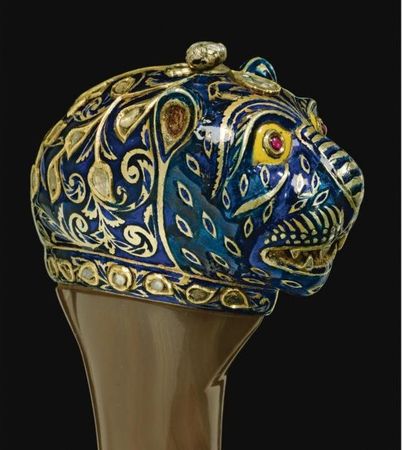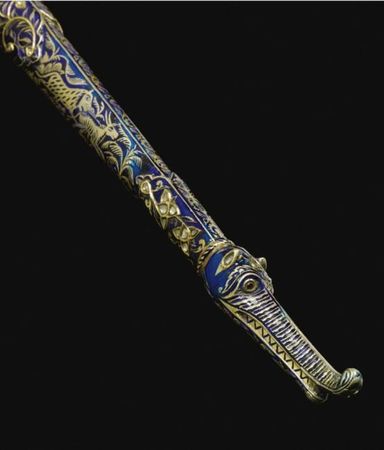An enamelled and agate-hilted dagger with bubri decoration and scabbard, possibly from the personal armoury of Tipu Sultan
An enamelled and agate-hilted dagger with bubri decoration and scabbard, possibly from the personal armoury of Tipu Sultan at Seringapatam, India, circa 1790. Photo Sotheby's
the slender tapering watered wootz steel blade of peshkabz form with broad back inlaid at the forte with gold bubri motif, the agate hilt of waisted khanjar form with an enamelled gold pommel rendered in the form of a tiger's head, decorated with foliate scrolls and tiger markings reserved on an enamelled blue ground and kundan set with cut diamonds and rubies to the eyes, the scabbard decorated ensuite with tiger hunting antelope amidst trees and a makara and fish within a lake, the chape rendered in the form of a makara, the lock decorated with flowering plants set with rose-cut diamonds. This lot is accompanied by a copy of Tiger of Mysore, The life and death of Tipu Sultan by Denys Forrest, London 1970.; 41.5cm. Estimate 25,000—35,000 GBP. Lot Sold 91,250 GBP
PROVENANCE: Ex-Collection Robin Wigington, Stratford-upon-Avon, England
Sotheby's. Arts of The Islamic World, 06 Apr 11, London www.sothebys.com
Oval portrait of Tipu Sultan wearing a jeweled turban seated against a bolster. . Painting ink, gouache, and gold on paper India, Karnataka, Mysore h 15 -1/8 x w 11 -13/16 inches, first quarter 19 century A.D. Berkeley Art Museum/Pacific Film Archive
Tipu Sultan (Kannada: ಟಿಪ್ಪು ಸುಲ್ತಾನ್, Urdu: سلطان فتح علی خان ٹیپو ) (November 1750, Devanahalli – 4 May 1799, Srirangapattana), also known as the Tiger of Mysore, was the de facto ruler of the Kingdom of Mysore. He was the son of Hyder Ali, at that time an officer in the Mysorean army, and his second wife, Fatima or Fakhr-un-nissa. His full name was Sultan Fateh Ali Khan Shahab, Tipu Saheb or Bahadur Khan Tipu Sultan.
During Tipu's childhood, his father rose to take power in Mysore, and Tipu took over rule of the kingdom upon his father's death. In addition to his role as ruler, he was a scholar, soldier, and poet. He was a devout Muslim but the majority of his subjects were Hindus. At the request of the French, he built a church, the first in Mysore. He was proficient in many languages.[1] In alliance with the French in their struggle with the British, and in Mysore's struggles with other surrounding powers, both Tipu Sultan and Hyder Ali used their French trained army against the Marathas, Sira, Malabar, Coorg, Bednur, Carnatic, and Travancore. He won important victories against the British in the Second Anglo-Mysore War, and negotiated the 1784 Treaty of Mangalore with them after his father died the previous year. Due to the atrocities carried out by Tipu in South Canara and Malabar and his expansionist intentions further south, the kingdom of Thiruvithamkoor (Travancore) ruled by Dharmaraja Karthika Thirunal Rama Varma, entered into a treaty with the British East India Company. As foreseen, Tipu attacked Travancore at Nedumkotta (present day Aalua)in 1789. The numerically vast forces of Tipu was effectively checked by the Travancore forces under the command of Diwan Raja Kesavadas. As per the treaty the East India Company joined forces with Travancore and Tipu's forces were driven out. This was the beginning of the Third Anglo Mysore War. Subsequently, the British East India Company saw this as an opportunity to crush Tipu and took the war beyond Travancore. In the ensuing battles Tipu lost all the areas that he had invaded such as Malabar and Mangalore. The attack on Travancore was the beginning of the end of Tipu Sultan. In the Fourth Anglo-Mysore War (1799) by the combined forces of the British East India Company, the Nizam of Hyderabad defeated Tipu and he was killed on 4 May 1799, defending the fort of Srirangapattana.
Sir Walter Scott, commenting on the abdication of Napoleon Bonaparte in 1814, wrote: "Although I never supposed that he [Napoleon] possessed, allowing for some difference of education, the liberality of conduct and political views which were sometimes exhibited by old Haidar Ali, yet I did think he might have shown the same resolved and dogged spirit of resolution which induced Tipu Sahib to die manfully upon the breach of his capital city with his sabre clenched in his hand." (Wikipedia)

/https%3A%2F%2Fprofilepics.canalblog.com%2Fprofilepics%2F1%2F0%2F100183.jpg)
/https%3A%2F%2Fstorage.canalblog.com%2F03%2F02%2F119589%2F96711876_o.jpg)
/https%3A%2F%2Fstorage.canalblog.com%2F11%2F31%2F119589%2F94773502_o.jpg)
/https%3A%2F%2Fstorage.canalblog.com%2F20%2F83%2F119589%2F94772815_o.jpg)
/https%3A%2F%2Fstorage.canalblog.com%2F26%2F72%2F119589%2F75604929_o.jpg)
/https%3A%2F%2Fstorage.canalblog.com%2F59%2F60%2F119589%2F26458628_o.jpg)








/http%3A%2F%2Fstorage.canalblog.com%2F06%2F39%2F119589%2F129007933_o.jpg)
/http%3A%2F%2Fstorage.canalblog.com%2F83%2F41%2F119589%2F128989180_o.jpg)
/http%3A%2F%2Fstorage.canalblog.com%2F65%2F49%2F119589%2F128551133_o.jpg)
/http%3A%2F%2Fstorage.canalblog.com%2F11%2F78%2F119589%2F126903004_o.jpg)